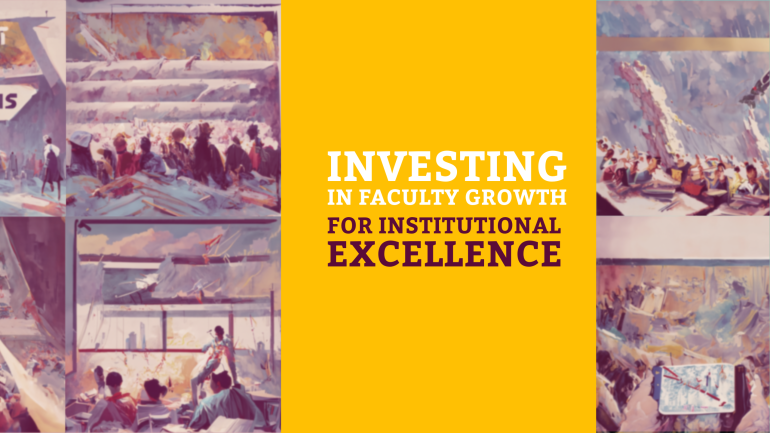Table of Contents
TL;DR: Elevating Institutional Excellence through Faculty Development
- Faculty development is critical: Investing in faculty growth is imperative for institutions to achieve excellence in education and research.
- Continuous training and support: Institutions should provide ongoing training, mentorship, and support to help faculty stay updated and excel in their roles.
- Promote a culture of collaboration: Encouraging collaboration among faculty members can lead to innovative research, improved teaching methods, and a stronger academic community.
- Recognize and reward excellence: Institutions should have mechanisms in place to acknowledge and reward faculty members for their outstanding contributions to teaching, research, and service.
- Invest in resources: Providing faculty with the necessary resources, such as technology, research facilities, and professional development opportunities, is crucial for their growth and the institution’s success.
Many educational institutions across the globe are realizing the importance of investing in faculty growth to achieve institutional excellence. Faculty members are at the core of academia, molding young minds, conducting groundbreaking research, and shaping the future of various fields. It is crucial for universities and colleges to prioritize the professional development of their educators to ensure quality teaching, impactful research, and overall institutional success.
Mapping Faculty Development Needs
There’s a critical need for institutions to identify and understand the development needs of their faculty in order to enhance institutional excellence. Mapping out these needs provides a roadmap for focused and strategic faculty development initiatives that align with the goals and objectives of the institution. By adopting a systematic approach to mapping faculty development needs, institutions can effectively support their faculty in achieving their potential and contributing to the overall success of the institution.
Assessing Current Faculty Competencies
One of the initial steps in mapping faculty development needs is assessing the current competencies of faculty members. This process involves evaluating the knowledge, skills, and abilities of faculty members in relation to their roles and responsibilities within the institution. This assessment can be done through various methods such as surveys, interviews, and performance evaluations to gain a comprehensive understanding of where faculty members excel and where they may need further development.
Identifying Institutional Goals and Objectives
The process of mapping faculty development needs must be aligned with the institutional goals and objectives to ensure that faculty development efforts support the overarching mission of the institution. By identifying the specific goals and objectives of the institution, faculty development initiatives can be tailored to address areas of improvement that will ultimately contribute to the advancement of the institution as a whole. The alignment of faculty development needs with institutional goals creates a cohesive approach to fostering growth and excellence within the institution.
Faculty development initiatives that are in line with institutional goals and objectives have a higher chance of success as they directly contribute to the overall strategic direction of the institution. By focusing on areas that are critical to the institution’s success, faculty development efforts become more targeted and impactful, leading to enhanced performance and outcomes for both faculty members and the institution.
Designing Effective Faculty Development Programs
Some of the most successful institutions prioritize faculty growth through well-designed faculty development programs. These programs are vital for enhancing teaching effectiveness, promoting scholarly activities, and fostering a culture of continuous learning among faculty members. To ensure the effectiveness of faculty development initiatives, institutions must carefully design programs that address the diverse needs and goals of their faculty.
Establishing Core Competencies and Learning Outcomes
Learning outcomes and core competencies serve as the foundation for any faculty development program. By clearly defining the knowledge, skills, and attitudes that faculty members are expected to gain, institutions can align their professional development activities with the overarching goals of the institution. Establishing measurable learning outcomes also enables institutions to assess the impact of their programs and make data-driven decisions to continuously improve and tailor their offerings.
Tailoring Programs to Diverse Faculty Needs
Tailoring faculty development programs to the diverse needs of faculty members is crucial for their success. Faculty members come from various backgrounds, disciplines, career stages, and teaching experiences, so a one-size-fits-all approach is ineffective. To maximize the impact of faculty development initiatives, institutions must offer customized programs that cater to the unique needs of different faculty cohorts. Providing options for self-directed learning, group workshops, mentoring opportunities, and peer collaboration can help ensure that faculty members receive the support and resources they need to thrive in their roles.
Strategic Investment in Faculty Development
Allocating Resources and Budgeting
Faculty growth and development are crucial for the success of any academic institution. Many forward-thinking universities understand the importance of investing in their faculty members to enhance teaching, research, and service. Allocating resources and budgeting for faculty development programs should be a strategic priority for institutions aiming for excellence.
Faculty development initiatives can include workshops, seminars, conferences, sabbaticals, and ongoing training programs. By providing financial support and resources for these activities, universities can empower their faculty members to stay current in their fields and continuously improve their skills.
Securing Long-term Commitment from Institutional Leadership
To ensure sustained investment in faculty growth, it is crucial to secure long-term commitment from institutional leadership. The support and endorsement of university leaders can significantly impact the prioritization of faculty development initiatives and the allocation of resources.
Implementing Professional Development Initiatives
Professional Development Workshops and Seminars
Unlike traditional one-off training sessions, professional development workshops and seminars offer faculty members the opportunity to engage in interactive learning experiences that are directly relevant to their teaching methods and research interests. These initiatives are designed to foster a culture of continuous learning and improvement among faculty, allowing them to stay abreast of new trends in their field and enhance their skills.
Mentoring and Coaching for Faculty
Development
Professional mentoring and coaching programs are important for promoting the growth and development of faculty members. Through one-on-one guidance and support, experienced mentors can help junior faculty navigate the challenges of academia, providing valuable insights and advice that contribute to their professional success. By pairing mentors with mentees based on their areas of expertise and goals, institutions can facilitate meaningful connections that support the career advancement of their faculty members.
To further enhance the effectiveness of mentoring and coaching initiatives, it is crucial to provide ongoing training and resources for both mentors and mentees. Institutions should establish clear guidelines and assessment mechanisms to ensure that these programs are meeting their objectives and fostering a culture of collaboration and growth among faculty members.
Evaluating the Impact of Faculty Development
Measuring Program Effectiveness
Effectiveness in faculty development programs must be measured to ensure that resources are utilized efficiently and outcomes are achieved. Various evaluation methods such as pre- and post-surveys, participant feedback, and faculty performance reviews can be utilized to assess program impact. It is vital to gather data on changes in teaching practices, student engagement, and faculty satisfaction to gauge the effectiveness of professional development initiatives.
Linking Faculty Growth to Student Success and Institutional Performance
With a well-designed faculty development program, institutions can witness a direct correlation between faculty growth and improved student success as well as institutional performance. By aligning faculty training with institutional goals and student learning outcomes, universities can enhance overall academic quality and reputation. Research shows that faculty who engage in continuous professional development contribute significantly to student retention, graduation rates, and overall institutional success.
Faculty development programs play a crucial role in advancing teaching effectiveness, fostering innovation in curriculum design, and promoting a culture of continuous improvement within academic institutions. By investing in faculty growth, universities not only elevate the quality of education they offer but also bolster their position in the competitive higher education landscape. The alignment of faculty development efforts with strategic priorities ensures sustainable growth and long-term excellence for the institution.
Technology and Faculty Development
Leveraging Online Platforms for Continuous Learning
To keep up with the rapidly evolving educational landscape, faculty members must continuously enhance their skills and knowledge. The advancement of technology has made it possible for educators to engage in continuous learning through online platforms. The flexibility and accessibility of these platforms allow faculty to pursue professional development opportunities without geographical constraints. They can participate in webinars, online courses, and virtual conferences to stay updated on the latest teaching methodologies, educational technologies, and research trends. By leveraging online platforms, institutions can empower their faculty to enhance their teaching practices and contribute to the overall institutional excellence.
Digital Tools and Resources for Scholarly Advancement
Technology offers a plethora of digital tools and resources to support faculty members in their scholarly pursuits. These tools include online databases, research repositories, citation management software, collaborative writing platforms, and data analysis tools. By incorporating these digital resources into their workflow, faculty members can streamline their research processes, collaborate more efficiently with colleagues, and increase the impact of their scholarly work. Additionally, these tools enable faculty to stay organized, manage large volumes of data, and stay current with the latest research in their field.
Plus, it is crucial for institutions to provide faculty with training and support in utilizing these digital tools effectively. By investing in faculty growth in the area of digital scholarship, institutions can equip their faculty with the necessary skills to excel in their research endeavors and contribute to the overall academic excellence of the institution.
Fostering a Culture of Continuous Improvement
All institutions aspire to achieve excellence, and one of the key ingredients for success is fostering a culture of continuous improvement. Culture plays a crucial role in shaping the behavior and mindset of faculty members towards embracing change, innovation, and ongoing development. All faculty members must be committed to lifelong learning and professional growth to keep abreast of the latest trends and advancements in their respective fields.
Encouraging a Mindset of Lifelong Learning
Culture within an institution should prioritize the value placed on continuous learning and improvement. Encouraging a mindset of lifelong learning involves creating opportunities for faculty to engage in ongoing professional development, attend workshops, conferences, and pursue advanced degrees. Institutions can also promote a culture of continuous improvement by recognizing and rewarding faculty members who demonstrate a commitment to their own growth and development.
Building Communities of Practice within the Institution
An imperative aspect of fostering a culture of continuous improvement is building communities of practice within the institution. These communities bring together faculty members with shared interests and goals to collaborate, exchange ideas, and support each other in their professional growth. By creating these communities of practice, institutions can facilitate knowledge-sharing, mentorship, and collective problem-solving among faculty members.
This collaborative approach not only enhances the professional development of faculty members but also strengthens the overall institutional culture of continuous improvement. By fostering a sense of belonging and shared purpose among faculty members, institutions can create a supportive environment that empowers individuals to strive for excellence and contribute positively to the institution’s growth and success.
FAQ
Q: Why is investing in faculty growth important for institutional excellence?
A: Investing in faculty growth is crucial for institutional excellence as it enhances teaching quality, promotes research productivity, and contributes to a positive campus culture.
Q: How does investing in faculty growth benefit the students?
A: Investing in faculty growth benefits students by providing them with access to high-quality education, mentorship, and cutting-edge research opportunities, which ultimately enhances their learning experience.
Q: What are some common ways institutions can invest in faculty growth?
A: Institutions can invest in faculty growth through professional development programs, research grants, teaching evaluations, mentorship opportunities, sabbatical leaves, and competitive salaries and benefits.
Q: How can investing in faculty growth help with faculty retention and recruitment?
A: Investing in faculty growth can help with faculty retention and recruitment by creating a supportive and stimulating work environment that attracts top talent and encourages current faculty to stay and thrive within the institution.
Q: What are some long-term benefits of investing in faculty growth for institutional excellence?
A: Some long-term benefits of investing in faculty growth include improved academic reputation, increased student enrollment, higher graduation rates, enhanced research output, and overall institutional advancement and sustainability.




